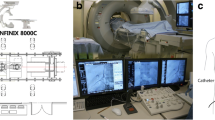4. Conclusion
In our experience ClariscanTM improves image quality, thus, increasing the visual length and improving the actual visible dimensions of the coronary arteries. Distal segments improved to a higher extent than the proximal parts. In that way sensitivity and specificity for the detection of significant coronary artery disease could be improved. Better SNR and CNR can be used to improve spatial resolution or to reduce scan time by techniques like SENSE or SMASH [14,15].
Similar content being viewed by others
References
Manning WJ, Li W, Edelman RR. A preliminary report comparing magnetic resonance coronary angiography with conventional angiography. N Engl J Med (see comments) 1993;328:828–32. (published erratum appears in N Engl J Med Jan 13;330(2):152).
Edelman RR, Manning WJ, Pearlman J, Li W. Human coronary arteries: projection angiograms reconstructed from breath-hold two-dimensional MR images. Radiology 1993;187:719–22.
Duerinckx AJ, Atkinson DP, Mintorovitch J, Simonetti OP, Vrman MK. Two-dimensional coronary MRA: limitations and artifacts. Eur Radiol 1996;6:312–25 published erratum appears in Eur Radiol 1996;6(5):703.
Sakuma H, Caputo GR, Steffens JC, O’Sullivan M, Bourne MW, Shimakawa A, et al. Breath-hold MR cine angiography of coronary arteries in healthy volunteers: value of multiangle oblique imaging planes. Ajr Am J Roentgenol 1994;163:533–7.
Pennell DJ, Keegan J, Firmin DN, Gatehouse PD, Underwood SR, Longmore DB. Magnetic resonance imaging of coronary arteries: technique and preliminary results. Br Heart J 1993;70:315–26.
Cho ZH, Mun CW, Friedenberg RM. NMR angiography of coronary vessels with 2D planar image scanning. Mag Reson Med 1991;20:134–43.
Duerinckx AJ, Urman MK. Two-demensional coronary MR angiography: analysis of initial clinical results (see comments). Radiology 1994;193:731–8.
Wang Y, Rossman PJ, Grimm RC, Riederer SJ, Ehman RI. Navigator-echo-based real-time respiratory gating and triggering for reduction of respiration effects in three-dimensional coronary MR angiography. Radiology 1996;198:55–60.
Achenbach S, Kessler W, Moshage WE, Ropers D, Zink D, Krocher R, et al. Visualization of the coronary arteries in three-dimenstonal reconstructions using respiratory gated magnetic resonance imaging. Coron Art Dis 1997;8:441–8.
McConnell MV, Khasgiwala VC, Savord BJ, Chen MH, Chuang ML, Edelman RR, et al. Prospective adaptive navigator correction for breath-hold MR coronary angiography. Magn Reson Med 1997;37:148–52.
Woodard PK, Li D, Haacke EM, Dhawale PJ, Kaushikkar S, Barzilai B, et al. Detection of coronary stenoses on source and projection images using three-dimensional MR angiography with retrospective respiratory gating: preliminary experience (see comments). Ajr Am J Roentgenol 1998;170:883–8.
Nagel E, Bornstedt A, Schnackenburg B, Hag J, Oswald H, Fleck E. Optimization of realtime adaptive naugator correction for 3D magnetic resonance coronary angiography. Mag Reon Med 1999;42:408–11.
Kellar KE, Fujii DK, Gunther WH, Briley-Saebo K, Bjornerud A, Spiller M, et al. NC100150 Injection, a preperation of optimized iron oxide nanoparticles for positive-contrist MR angiography. J Mag Reson Imaging 2000;11:488–94.
Weiger M., Scheidegger M.B., Prüssmann K.P., Boesiger P. Cardiac real-time acquisition using coil snsitivity encoding. Proc Int Soc Magn Reson Med 1998:803.
Sodickson DK, Manning WJ. Simultanious acquisition of spatial harmonics (SMASH): fast imaging with radiofrequency coil arrays. Magn Reson Med 1997;38:591–603.
Author information
Authors and Affiliations
Corresponding author
Rights and permissions
About this article
Cite this article
Klein, C., Nagel, E., Schnackenburg, B. et al. The intravascular contrast agent Clariscan™ (NC 100150 injection) for 3D MR coronary angiography in patients with coronary artery disease. MAGMA 11, 65–67 (2000). https://doi.org/10.1007/BF02678498
Received:
Accepted:
Published:
Issue Date:
DOI: https://doi.org/10.1007/BF02678498




